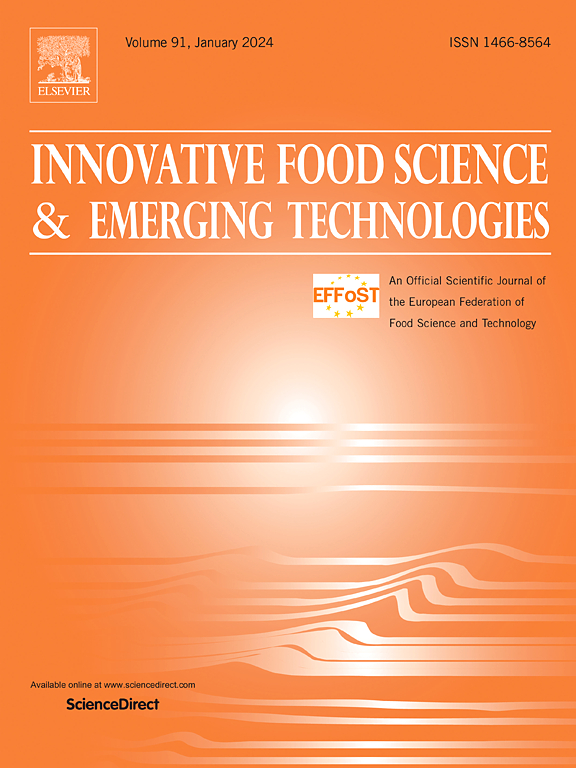高压均质对商品豌豆分离蛋白理化性质、流动特性和热凝胶化的影响
IF 6.3
1区 农林科学
Q1 FOOD SCIENCE & TECHNOLOGY
Innovative Food Science & Emerging Technologies
Pub Date : 2025-06-30
DOI:10.1016/j.ifset.2025.104083
引用次数: 0
摘要
作为植物性食品中新兴的蛋白质来源,商品豌豆分离蛋白(cPPI)在生产过程中由于蛋白质变性和聚集而导致热凝胶性差。高压均质(HPH)是一种很有前途的破坏蛋白质聚集的物理方法。本研究考察了HPH对在50、100和200 MPa下均质化的8.5% w/w cPPI分散体和未均质化的cPPI分散体的物理化学性质(即蛋白质分散性、粒径、表面疏水性和游离SH基团)、流动行为和热凝胶化(流变凝胶性质以及所涉及的分子机制)的影响。HPH显著提高了蛋白质的分散性(从24%增加到86%),并减小了颗粒尺寸(D[3,2]从44.0 μm减少到0.5μm)。表面疏水性增加,游离SH基团含量下降。HPH处理后,流体行为从牛顿假塑性转变为宾厄姆假塑性,这种转变在200 MPa时加剧。HPH处理的cPPI分散体的热凝胶化表现出更有弹性(更低的tanδ)、更稳定(更低的n ‘)、更硬(更高的K ’)、更易变形(更高的ϵc)和更不脆(更高的ϵy)的凝胶网络,特别是在200 MPa时。热凝胶化主要由疏水相互作用驱动。二硫键和氢键的作用有限。这些发现表明,HPH破坏了大的不可分散的变性蛋白聚集体,使其变成较小的可分散的聚集体,暴露出对cPPI分散体热凝胶化至关重要的疏水区域。本文章由计算机程序翻译,如有差异,请以英文原文为准。

The effect of high-pressure homogenization on physicochemical properties, flow behavior and thermal gelation of commercial pea protein isolate
As an emerging protein source in plant-based foods, commercial pea protein isolate (cPPI) often suffers from poor thermal gelation properties due to protein denaturation and aggregation stemming from its production process. High-pressure homogenization (HPH) is a promising physical method to disrupt protein aggregates. This study examined the effect of HPH on the physicochemical properties (i.e., protein dispersibility, particle size, surface hydrophobicity, and free SH groups), flow behavior and thermal gelation (rheological gel properties as well as molecular mechanisms involved) of an 8.5% w/w cPPI dispersion homogenized at 50, 100, and 200 MPa, compared to an unhomogenized cPPI dispersion. HPH significantly increased protein dispersibility (from 24% to 86%) and reduced particle size ( from 44.0 to ). Surface hydrophobicity increased, while the content of free SH groups declined. Upon HPH treatment, the flow behavior shifted from Newtonian to Bingham pseudoplastic, with this shift intensifying at 200 MPa. Thermal gelation of HPH treated cPPI dispersions exhibited a more elastic (lower ), more stable (lower ), stiffer (higher ), and more deformable (higher ) and less brittle (higher ) gel network, particularly at 200 MPa. The thermal gelation was primarily driven by hydrophobic interactions. Disulfide bonds and hydrogen bonds played limited roles. These findings indicated that HPH disrupts large indispersible denatured protein aggregates into smaller dispersible ones, exposing hydrophobic regions that are critical for thermal gelation of cPPI dispersions.
求助全文
通过发布文献求助,成功后即可免费获取论文全文。
去求助
来源期刊
CiteScore
12.00
自引率
6.10%
发文量
259
审稿时长
25 days
期刊介绍:
Innovative Food Science and Emerging Technologies (IFSET) aims to provide the highest quality original contributions and few, mainly upon invitation, reviews on and highly innovative developments in food science and emerging food process technologies. The significance of the results either for the science community or for industrial R&D groups must be specified. Papers submitted must be of highest scientific quality and only those advancing current scientific knowledge and understanding or with technical relevance will be considered.

 求助内容:
求助内容: 应助结果提醒方式:
应助结果提醒方式:


